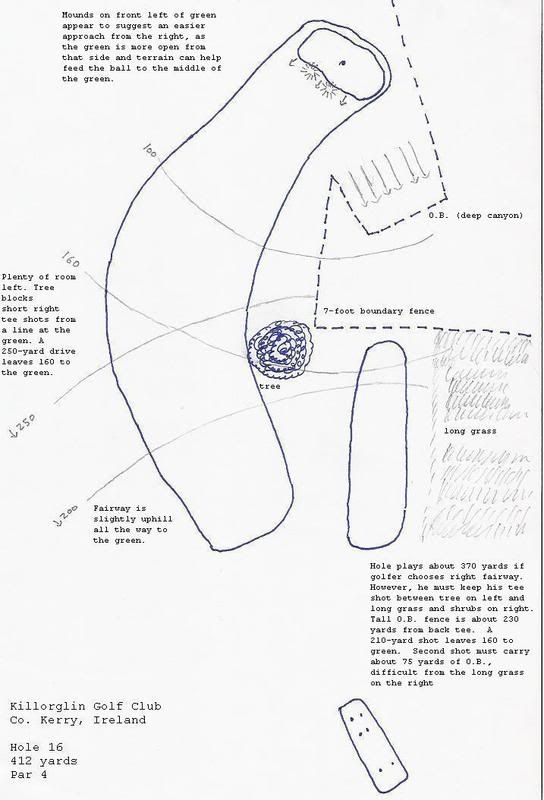I've wanted to discuss this hole for a while, but haven't found the place to do so until now. I was fortunate enough to play a few courses in the west of Ireland last summer (Killorglin, Dooks, Donegal Murvah, Narin & Portnoo, Enniscrone, Carne, Achill Island, Connemara, Lahinch). As our "warm-up round," we played Killorglin Golf Club in Co. Kerry. Overall the course was nothing to write home about, but the 16th hole caught my attention. Unfortunately I took no pictures and couldn't find any online, so I've drawn the hole out from memory (has anyone else played this hole?). Anyway, here's the diagram:

Here are a few reasons why I found this hole different and interesting. Please keep in mind I haven't played a ton of courses, so what's new to me may be old news to most of you:
1. Multiple fairways. I know there are many cases of holes with two routes, but this one is interesting in that the shorter route is cut off 230 yards from the tee, rather than the typical long carry for the shorter fairway. For many players, a driver down the left will leave the same distance to the green as a fairway wood or long iron down the right. For the short hitter, the question is whether to accept pitching his/her third shot onto the green, or risking a narrow fairway and a carry over the out of bounds.
2. The tall O.B. fence can create an interesting situation if a drive down the right fairway goes a bit too far (an unplayable or a pitch backwards would be the most likely outcome).
3. The long rough on the right puts the OB into play on the second shot. From the fairway, only a mishit ball will find the quarry. If the tee shot finds the right rough, however, the golfer must choose to go for the green with OB short and right, pitch out to the right fairway, or cut over the tree or OB to the left fairway for a shorter 3rd shot at the green.
4. The lone tree on the hole protects the player who chooses the left fairway from hitting OB, but also forces him to aim farther left to avoid being stymied on his approach shot. It also prevents golfers from aiming for the short rough between the two fairways for the shortest line to the hole.
5. The green angle is interesting; it seems to me to favor a shot from the right fairway, but I'm not sure.
I'm interested in hearing your opinions on this hole. Is it a good hole? Too much OB for your taste? Could it be improved? Which line do you think would be taken more often? If you have any further questions on the anatomy of the hole, I'll answer them to the best of my memory. Also, I'd be happy to take suggestions on how to make my drawing or future drawings better.
Thanks,
Ian